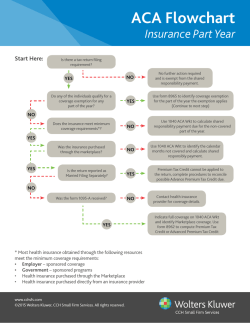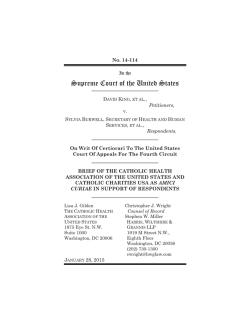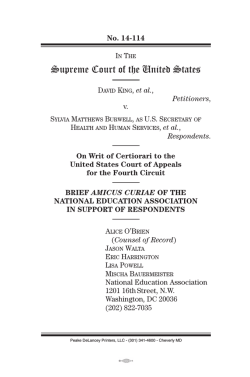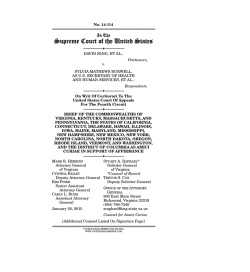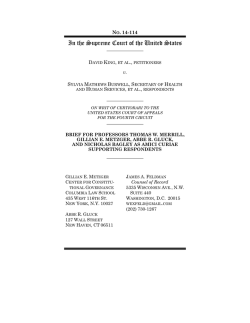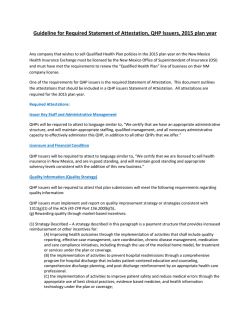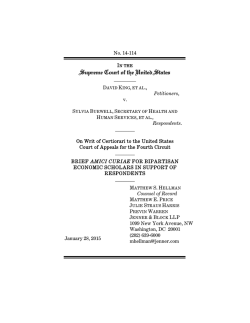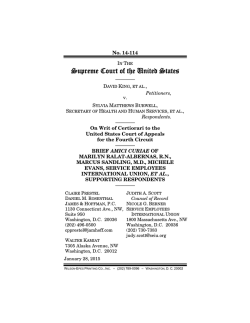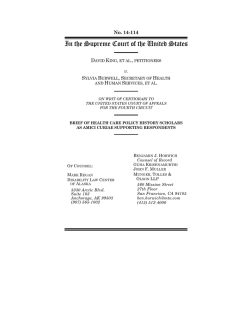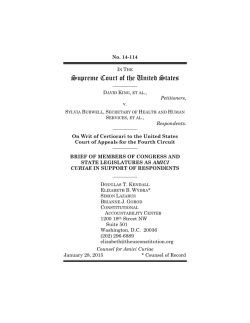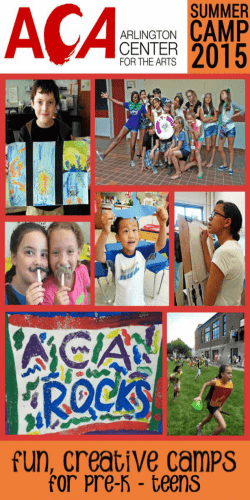
Families USA - PremiumTaxCredits
No. 14-114 IN THE Supreme Court of the United States ———— DAVID KING, ET AL., v. Petitioners, SYLVIA BURWELL, SECRETARY OF HEALTH AND HUMAN SERVICES, ET AL., Respondents. ———— On Writ of Certiorari to the United States Court of Appeals for the Fourth Circuit ———— BRIEF OF AMICUS CURIAE FAMILIES USA IN SUPPORT OF RESPONDENTS ———— ROBERT N. WEINER Counsel of Record ARNOLD & PORTER LLP 555 12th Street, NW Washington, DC 20004 (202) 942-5000 [email protected] January 28, 2015 WILSON-EPES PRINTING CO., INC. – (202) 789-0096 – WASHINGTON, D. C. 20001 TABLE OF CONTENTS TABLE OF AUTHORITIES ................................ ii INTEREST OF AMICUS CURIAE ..................... 1 SUMMARY OF ARGUMENT ............................. 4 ARGUMENT ........................................................ 12 I. PETITIONERS’ INTERPRETATION WOULD DISABLE A STATUTE THAT IS FUNCTIONING EFFECTIVELY........ 12 II. THE TEXT OF THE ACA PRECLUDES PETITIONERS’ INTERPRETATION ...... 25 CONCLUSION .................................................... 35 (i) ii TABLE OF AUTHORITIES Page(s) CASES Alaska Airlines, Inc. v. Brock, 480 U.S. 678 (1987) ...................................... 12 Brown v. Gardner, 513 U.S. 115 (1994) ...................................... 29 Burgess v. United States, 553 U.S. 124 (2008) ...................................... 26, 29 Chevron U.S.A., Inc. v. Natural Res. Def. Council, Inc., 467 U.S. 837 (1984) ...................................... 7 Freytag v. Comm’r, 501 U.S. 868 (1991) ...................................... 32 Halbig v. Burwell, 758 F.3d 390 (D.C. Cir. 2014) ...................... 30 Hollingsworth v. Perry, 133 S. Ct. 2652 (2013) .................................. 6 In re Arctic Exp. Inc., 636 F.3d 781 (6th Cir. 2011) ........................ 27-28 In re Nail, 680 F.3d 1036 (8th Cir. 2012) ...................... 27 Nat’l Fed’n of Indep. Bus. v. Sebelius, 132 S. Ct. 2566 (2012) .............................. 6, 12, 16 Powerex Corp. v. Reliant Energy Servs., Inc., 551 U.S. 224 (2007) ...................................... 29 Rapanos v. United States, 547 U.S. 715 (2006) ...................................... 32 Rumsfeld v. Padilla, 542 U.S. 426 (2004) ...................................... 32 iii TABLE OF AUTHORITIES—Continued Page(s) Skilling v. United States, 561 U.S. 358 (2010) ...................................... 32 Sunshine Anthracite Coal Co. v. Adkins, 310 U.S. 381 (1940) ...................................... 7 United States v. Powers, 307 U.S. 214 (1939) ...................................... 7 STATUTES Patient Protection and Affordable Care Act (ACA), Pub. L. No. 111-148, 124 Stat. 119: Tit. I, 124 Stat. 130 ...................................... 13 Subtit. A, 124 Stat. 130 ............................ 13 Subtit. C, 124 Stat. 154 ............................ 13 Subtit. D, 124 Stat. 162 ............................ 13 Subtit. E, 124 Stat. 213 ............................ 13 Tit. X, 124 Stat. 883 ..................................... 13 ACA § 1001 (42 U.S.C. § 300gg-11) ................. 15 ACA § 1201 (42 U.S.C. § 300gg) ...................... 15 ACA § 1301(a)(1) (42 U.S.C. § 18021(a)(1))..... 29 ACA § 1311 (42 U.S.C. § 18031) .................. 9, 27, 30 ACA § 1311(b)(1) (42 U.S.C. § 18031(b)(1))..... 26 ACA § 1311(d)(1) (42 U.S.C. § 18031(d)(1)) .... 26 ACA § 1311(e)(1)(B) (42 U.S.C. § 18031(e)(1)(B)) ........................................... 31 ACA § 1311(f)(3)(A) (42 U.S.C. § 18031(f)(3)(A)) ............................................ 32 iv TABLE OF AUTHORITIES—Continued Page(s) ACA §§ 1311-1421 (42 U.S.C. §§ 1802118063)............................................................ 25 ACA § 1312(f) (42 U.S.C. § 18032(f)) ............... 30 ACA § 1321 (42 U.S.C. § 18041) .......... 10, 29, 30, 35 ACA § 1321(c) (42 U.S.C. § 18041(c)) .... 9, 26, 31, 35 ACA § 1411(b)(3) (42 U.S.C. § 18081(b)(3))..... 34 ACA § 1411(c)(3) (42 U.S.C. § 18081(c)(3)) ..... 34 ACA § 1411(e)(2)(A) (42 U.S.C. § 18081(e)(2)(A)) ........................................... 34 ACA § 1411(e)(4)(B)(ii) (42 U.S.C. § 18081(e)(4)(B)(ii)) ....................................... 34 ACA § 1413(a) (42 U.S.C. § 18083(a)) ............. 33 ACA § 1413(e)(1) (42 U.S.C. § 18083(e)(1)) ..... 33 ACA § 1501(a)(2)(C) (42 U.S.C. § 18091(2)(C)) ............................................... 13 ACA § 1501(a)(2)(D) (42 U.S.C. § 18091(2)(D)) ............................................... 13 ACA § 1501(a)(2)(E) (42 U.S.C. § 18091(2)(E)) ............................................... 13, 23 ACA § 1501(a)(2)(F) (42 U.S.C. § 18091(2)(F))................................................ 1, 13 ACA § 1501(a)(2)(G) (42 U.S.C. § 18091(2)(G)) ............................................... 13 ACA § 1563 (42 U.S.C. § 300gg-91(d)(21)) ...... 26 ACA § 2001 (42 U.S.C. § 1396a(gg)(1)) ........... 32 ACA § 2101(b) (42 U.S.C. § 1397ee(d)(3)(B)) .. 32 v TABLE OF AUTHORITIES—Continued Page(s) ACA § 2101(b) (42 U.S.C. § 1397ee(d)(3)(C)) .. 32 ACA § 2201(b)(1)(B) (42 U.S.C. § 1396w3(b)(1)(B)) ...................................................... 32 ACA § 2201(b)(1)(D) (42 U.S.C. § 1396w3(b)(1)(D))...................................................... 32 ACA § 2201(b)(2) (42 U.S.C.§ 1396w-3(b)(2)).. 32 ACA § 2201(b)(4) ( 42 U.S.C.§ 1396w-3(b)(4)). 32 ACA § 10106 (42 U.S.C. § 18091(2)(F)) ........... 1 26 U.S.C. § 36B .......................................... 31, 33, 35 26 U.S.C. § 36B(a) ............................................ 8, 33 26 U.S.C. § 36B(b) ............................................ 33 26 U.S.C. § 36B(b)(2) ....................................... 33-34 26 U.S.C. § 36B(b)(2)(A)......................... 8, 25, 32, 33 26 U.S.C. § 36B(c)(1)(A) ................................... 33 26 U.S.C. § 36B(c)(2)(A) ............................ 8-9, 32, 34 26 U.S.C. § 36B(c)(2)(A)(i) ............................... 32 26 U.S.C. § 36B(g) ............................................ 24 42 U.S.C. § 300gg (ACA § 1201) ...................... 15 42 U.S.C. § 300gg-11 (ACA § 1001) ................. 15 42 U.S.C. § 300gg-91(d)(21) ............................. 26 42 U.S.C. § 1396a(gg)(1) (ACA § 2001) ........... 32 42 U.S.C. § 1396c ............................................. 35 42 U.S.C. § 1396w-3(b)(1)(B) (ACA § 2201(b)(1)(B)) ............................................. 32 vi TABLE OF AUTHORITIES—Continued Page(s) 42 U.S.C. § 1396w-3(b)(1)(D) (ACA § 2201(b)(1)(D)) ............................................. 32 42 U.S.C. § 1396w-3(b)(2) (ACA § 2201(b)(2)) .................................................. 32 42 U.S.C. § 1396w-3(b)(4) (ACA § 2201(b)(4)) .................................................. 32 42 U.S.C. § 1397ee(d)(3)(B) (ACA § 2101(b)) ...................................................... 32 42 U.S.C. § 1397ee(d)(3)(C) (ACA § 2101(b)) ...................................................... 32 42 U.S.C. § 18021(a)(1) (ACA § 1301(a)(1)) .................................................. 29 42 U.S.C. §§ 18021-18063 (ACA §§ 1311-1421) ................................................ 25 42 U.S.C. § 18031 (ACA § 1311) ........................................................... 9 42 U.S.C. § 18031(f)(3)(A) (ACA § 1311(f)(3)(A)) .............................................. 32 42 U.S.C. § 18032(f) (ACA § 1312(f)) ....................................................... 30 42 U.S.C. § 18041(c) (ACA § 1321(c)) ....................................................... 9 42 U.S.C. § 18081(b)(3) (ACA § 1411(b)(3)) .................................................. 34 42 U.S.C. § 18081(c)(3) (ACA § 1411(c)(3)) .................................................. 34 42 U.S.C. § 18081(e)(2)(A) (ACA § 1411(e)(2)(A)) ............................................. 34 vii TABLE OF AUTHORITIES—Continued Page(s) 42 U.S.C. § 18081(e)(4)(B)(ii) (ACA § 1411(e)(4)(B)(ii)) ......................................... 34 42 U.S.C. § 18083(a) (ACA § 1413(a)) ...................................................... 33 42 U.S.C. § 18091(2)(F) (ACA § 1501(a)(2)(F)) ............................................. 1 OTHER AUTHORITIES 26 C.F.R. § 1.36B-1(k) ...................................... 7 26 C.F.R. § 1.36B-2(a) ...................................... 7 45 C.F.R. § 160.103 .......................................... 28 79 Fed. Reg. 3593 (Jan. 22, 2014) ................... 19 155 Cong. Rec. S12798 (Dec. 9, 2009) ............. 20 156 Cong. Rec. S1841 (Mar. 23, 2010)............. 21 Fed. R. Civ. P. 12(a)(1)(A) ................................ 27-28 Sup. Ct. R. 37 ................................................... 1 Drew Altman, Kaiser Family Foundation, How 13 Million Americans Could Lose Insurance Subsidies (Nov. 19, 2014), http://kff.org/health-reform/perspective/ how-13-million-americans-could-loseinsurance-subsidies/ ..................................... 19 Allison Bell, LifeHealthPro, More PPACA Exchange Users Get Premium Subsidies (Dec. 30, 2014), http://www.lifehealthpro. com/2014/12/30/more-ppaca-exchangeusers-get-premium-subsidies. ...................... 18 viii TABLE OF AUTHORITIES—Continued Page(s) Linda Blumberg et al., Robert Wood Johnson Foundation, The Implications of a Supreme Court Finding for the Plaintiff in King vs. Burwell: 8.2 Million More Uninsured and 35% Higher Premiums (Jan. 2015), http://www.rwjf.org/content/dam/farm/repo rts/issue_briefs/2015/rwjf417289 .......... 4-5, 17, 19 Amy Burke et al., U.S. Dep’t of Health and Human Services, Premium Affordability, Competition, and Choice in the Health Insurance Marketplace, 2014 (June 18, 2014), http://aspe.hhs.gov/health/reports/20 14/premiums/2014mktplaceprembrf.pdf ..... 4 Sara Collins et al., The Commonwealth Fund, The Rise in Health Care Coverage and Affordability Since Health Reform Took Effect (Jan. 2015), http://www.common wealthfund.org/~/media/files/publications/i ssue-brief/2015/jan/1800_collins_biennial_ survey_brief.pdf ............................................ 18 Congressional Budget Office: The Budget and Economic Outlook: 2015 to 2025 (Jan. 26, 2015), https:// www.cbo.gov/sites/default/files/cbofiles/att achments/49892-Outlook2015.pdf ........... 4, 16, 17 Updated Estimates of the Effects of the Insurance Coverage Provisions of the Affordable Care Act (Apr. 2014), https://www.cbo.gov/sites/default/files/4523 1-ACA_Estimates.pdf ................................... 5 ix TABLE OF AUTHORITIES—Continued Page(s) Cynthia Cox et al., Kaiser Family Foundation, Analysis of 2015 Premium Changes in the Affordable Care Act’s Health Insurance Marketplaces, Silver and Bronze Premium Changes from 2014 to 2015 (Jan. 6, 2015), http://kff.org/health-reform/issuebrief/analysis-of-2015-premium-changesin-the-affordable-care-acts-health-insuran ce-marketplaces/ ........................................... 15 Fred Dews, Brookings Institution, HHS Secretary Sylvia Burwell Says Affordable Care Act Is Working (Sept. 23, 2014), http://www.brookings.edu/blogs/brookingsnow/posts/2014/09/hhs-secretary-sylviaburwell-affordable-care-act-is-working ....... 5 Families USA: The Dangers of Defeat: The Cost of Failure to Pass Health Reform (Mar. 2010), http://familiesusa.org/sites/default/files/pro duct_documents/dangers-of-defeat.pdf ........ 2, 22 Dying for Coverage: The Deadly Consequences of Being Uninsured (June 2012), http://familiesusa.org/sites/default/ files/product_documents/Dying-forCoverage.pdf ................................................. 1, 22 Worry No More: Americans with PreExisting Conditions Are Protected by the Health Care Law (July 2012), http://familiesusa.org/sites/default/product _documents/National-Report_0.pdf ............. 14 x TABLE OF AUTHORITIES—Continued Page(s) Jason Furman & Matt Fiedler, White House Council of Economic Advisors, 2014 Has Seen Largest Coverage Gains in Four Decades, Putting the Uninsured Rate at or Near Historic Lows, http://www.white house.gov/blog/2014/12/18/2014-has-seenlargest-coverage-gains-four-decadesputting-uninsured-rate-or-near-his ............. 4 Jon Gabel et al., The Commonwealth Fund, Analysis Finds No Nationwide Increase In Health Insurance Marketplace Premiums (Dec. 22, 2014), http://www.commonwealth fund.org/publications/blog/2014/dec/zeroinflation-nationwide-for-marketplacepremiums ...................................................... 15 Linda Greenhouse, By Any Means Necessary, N.Y. Times, Aug. 20, 2014, http://www. nytimes.com/2014/08/21/opinion/linda-gree nhouse-by-any-means-necessary.html ........ 5 HealthCare.gov, Income levels that qualify for lower health coverage costs, https://www. healthcare.gov/qualifying-for-lower-costschart/ ............................................................. 19 Renee Hsia, M.D. et al., Health Care as a “Market Good’? Appendicitis as a Case Study, 172 Archives of Internal Med. 818 (2012) ............................................................ 22 Institute of Medicine, Coverage Matters: Insurance and Health Care (Sept. 2001) ..... 22 xi TABLE OF AUTHORITIES—Continued Page(s) Kaiser Comm. on Medicaid & the Uninsured, The Uninsured and the Difference Health Insurance Makes (Sept. 2012), http://kaiser familyfoundation.files.wordpress.com/2013 /01/1420-14.pdf ............................................. 21 Kaiser Family Foundation, Map: How Many Americans Could Lose Subsidies, http://kff. org/interactive/king-v-burwell/ .................... 5 Kaiser Family Foundation, Subsidy Calculator, http://kff.org/interactive/subsid y-calculator/ .................................................. 20 Kimberly Leonard, A State-by-State Look at Exchanges As Obamacare Deadline Looms, U.S. News & World Report (Dec. 15, 2014), http://www.usnews.com/news/articles/ 2014/12/15/a-state-by-state-look-atexchanges-as-obamacare-deadline-looms .... 16-17 Jenna Levy, Gallup, In U.S., Uninsured Rate Sinks to 12.9% (Jan. 7, 2015), http:// www.gallup.com/poll/180425/uninsuredrate-sinks.aspx ............................................. 16 Jessica May & Peter Cunningham, Center for Studying Health System Change, Tough Trade-Offs: Medical Bills, Family Finances and Access to Care, Issue Brief 85 (2004), http://www.hschange.org/CONTENT/689/6 89.pdf ............................................................ 23 Neal Meropol & Kevin Schulman, Cost of Cancer Care: Issues and Implications, 25 J. Clin. Oncol. 180 (2007) ................................. 22 xii TABLE OF AUTHORITIES—Continued Page(s) Merriam-Webster Dictionary (11th Ed.), http://www.merriam-webster.com/diction ary/qualified .................................................. 30-31 Kavita Patel, Brookings Institution, Is Obamacare Working? Yes. (Nov. 26, 2014), http://www.brookings.edu/research/ opinions/2014/11/24-is-obamacareworking-patel ................................................ 18 Jack Rodolico, Data Reveals Impact of the ACA on N.H.’s Uninsured, New Hampshire Public Radio (Oct. 30, 2014), http://nhpr. org/post/data-reveals-impact-aca-nhsuninsured ...................................................... 17 Evan Salzman & Christine Eibner, RAND Corporation, The Effect of Eliminating the Affordable Care Act’s Tax Credits in Federally Facilitated Marketplaces (Jan. 7, 2015), http://www.rand.org/pubs/research_ reports/RR980.html. ..................................... 22 Greg Sargent, Plum Line Happy Hour Roundup, Wash. Post, http://www.wash ingtonpost.com/blogs/plum-line/wp/2015/ 01/08/happy-hour-roundup-515/ .................. 23-24 Antonin Scalia & Bryan Garner, Reading Law: The Interpretation of Legal Texts (2012) ...........................................................passim Antonin Scalia, Judicial Deference to Administrative Interpretations of Law, 1989 Duke L.J. 511 (1989) ........................... 12 xiii TABLE OF AUTHORITIES—Continued Page(s) Benjamin Sommers, M.D. et al., Health Reform and Changes in Health Insurance Coverage in 2014, 371 New Eng. J. Med. 867 (2014) ..................................................... 4, 16 Jeffrey Sparshott, McConnell: Supreme Court is Best Hope for Obamacare ‘Do Over’, WSJ.com, http://blogs.wsj.com/washwire/ 2014/12/02/mcconnell-supreme-court-isbest-hope-for-obamacare-do-over/ ................ 23-24 Lena Sun & Amy Goldstein, Beneath health law’s botched rollout is basic benefit for millions of uninsured Americans, Wash. Post., Dec. 28, 2013, http://www. washingtonpost.com/national/health-sci ence/beneath-health-laws-botched-rolloutis-basic-benefit-for-millions-of-uninsuredamericans/2013/12/28/8ae8d93e-68e511e3-8b5b-a77187b716a3_story.html .......... 21 Ward Thomas & Leonard Henzke, Jr, Agency: A Critical Factor in Exempt Organizations and Ubit Issues, 2002 EO CPE Text, http://www.irs.gov/pub/irstege/eotopicc02.pdf ....................................... 28 Nathan Thompson, AG Touts Record on Safety, ACA, Bartlesville ExaminerEnterprise, Oct. 8, 2014, http://examinerenterprise.com/news/local-news/ag-toutsrecord-safety-aca .......................................... 23-24 xiv TABLE OF AUTHORITIES—Continued Page(s) U.S. Dep’t of Commerce, Census Bureau: Income, Poverty, and Health Insurance Coverage in the United States: 2009 (Sept. 2010), http://www.census.gov/prod/2010 pubs/p60-238.pdf .......................................... 16 Population Estimates: State Totals: Vintage 2014, http://www.census.gov/popest/data/ state/totals/2014/index.html ........................ 19 U.S. Dep’t of Health & Human Services: At Risk: Pre-Existing Conditions Could Affect 1 in 2 Americans (Nov. 2011), http://aspe.hhs.gov/health/reports/2012/pre -existing/ ....................................................... 14-15 Health Insurance Marketplace 2015 Open Enrollment Period: December Enrollment Report (Dec. 30, 2014), http://aspe.hhs.gov/ health/reports/2014/MarketPlaceEnrollme nt/Dec2014/ib_2014Dec_enrollment.pdf ...... 16, 19 Open Enrollment Week 9 (Jan. 21, 2015), http://www.hhs.gov/healthcare/facts/blog/2 015/01/open-enrollment-week-nine.html ..... 16 Dan Witters, Gallup, Arkansas, Kentucky Report Sharpest Drops in Uninsured Rate (Aug. 5, 2014), http://www.gallup.com/ poll/174290/arkansas-kentucky-reportsharpest-drops-uninsured-rate.aspx ........... 17, 18 INTEREST OF AMICUS CURIAE1 Amicus Families USA is a national non-partisan, non-profit organization that has represented the interests of health care consumers and promoted health care reform in the United States for more than 30 years. On behalf of health care consumers, Families USA has addressed the serious medical and financial harms inflicted on the millions of Americans without health insurance. For example, with regard to medical harms, a Families USA study showed that many uninsured forgo needed medical care because of cost, resulting in 26,100 premature deaths in 2010 alone.2 The financial injuries that Families USA has addressed arise because the uninsured, like everyone, face serious accidents and life-threatening illnesses, often resulting in ruinous medical debts. When the uninsured cannot pay, health care providers pass on the cost of their care by charging higher prices to other consumers, increasing the cost of health insurance for everyone.3 To remedy the harms from the widespread lack of health insurance, Families USA has backed reforms to achieve universal health insurance coverage. The 1 As required by Supreme Court Rule 37, all parties were timely notified and have consented to the filing of this brief. No counsel for any party authored this brief in whole or in part, and no person or entity other than amicus made a monetary contribution to its preparation or submission. 2 Families USA, Dying for Coverage: The Deadly Consequences of Being Uninsured, 2 (June 2012), http://familiesusa.org/sites/ default/files/product_documents/Dying-for-Coverage.pdf. 3 In 2010, that increase was $1,000 for an average family. Patient Protection and Affordable Care Act (“ACA”), Pub. L. No. 111-148, §§ 1501(a)(2)(F), 10106 (2010), codified at 42 U.S.C. § 18091(2)(F). 2 organization fought for the Affordable Care Act (“ACA”) and sponsored studies that helped shape it.4 Families USA also convened major, structured dialogues among key health stakeholders—including organizations representing health consumers with diverse demographic backgrounds and associations representing hospitals, physicians, insurers, pharmaceutical companies, businesses, and labor—to promote cooperative support for reform. The law that emerged from these efforts already has added 12 million Americans to the rolls of the insured and curbed the rising cost of insurance nationwide, marking significant progress toward universal, affordable health insurance coverage. A key to this progress has been tax relief to low-income families that enables them to pay for insurance. Given the role Families USA played in passing the ACA, the organization has a strong interest in its continued vitality, and, therefore, in the premium assistance central to it. Further, having long represented the interests of health care consumers, Families USA offers a valuable perspective on what this assistance has meant to real people already at or beyond the cusp of economic hardship and on the personal tragedies that will occur if Petitioners succeed in taking that assistance away from them. In addition, with the comprehensive expertise Families USA has gained regarding the statute—comprising more than 900 pages of interrelated sections—the organization can disentangle some of the complicated arguments presented here and shed light on how the statute is operating successfully in the marketplace. 4 E.g., Families USA, The Dangers of Defeat: The Cost of Failure to Pass Health Reform (Mar. 2010), http://familiesusa. org/sites/default/files/product_documents/dangers-of-defeat.pdf. 3 Families USA thus respectfully submits that its analysis will assist the Court. 4 SUMMARY OF ARGUMENT Espousing a false fidelity to statutory text, Petitioners ask this Court to knock down a pillar of the Affordable Care Act—an Act that, in its first year alone, reduced the number of uninsured Americans by 12 million.5 As a result of the Act, the drop in the uninsured rate in 2014 was the largest since the first days of Medicare and Medicaid in the early 1970s.6 More than 85 percent of purchasers on the federallyfacilitated Exchanges received tax assistance to afford health insurance. That assistance lowered the cost dramatically, resulting in monthly premiums under $100 for nearly seven out of ten purchasers on federally-facilitated Exchanges.7 Experts predict that by 2016, enrollment through the federally-facilitated Exchanges will exceed 13.6 million Americans, with by far most participants receiving premium assistance.8 5 Congressional Budget Office (“CBO”), The Budget and Economic Outlook: 2015 to 2025, 118 (Jan. 26, 2015), https://www.cbo.gov/sites/default/files/cbofiles/attachments/4989 2-Outlook2015.pdf. Earlier studies had estimated about a 10 million drop in the uninsured population. E.g., Benjamin Sommers, M.D. et al., Health Reform and Changes in Health Insurance Coverage in 2014, 371 New Eng. J. Med. 867, 871 (2014). 6 Jason Furman & Matt Fiedler, White House Council of Economic Advisors, 2014 Has Seen Largest Coverage Gains in Four Decades, Putting the Uninsured Rate at or Near Historic Lows, http://www.whitehouse.gov/blog/2014/12/18/2014-has-seen -largest-coverage-gains-four-decades-putting-uninsured-rate-ornear-his. 7 Amy Burke et al., U.S. Dep’t of Health and Human Services (“HHS”), Premium Affordability, Competition, and Choice in the Health Insurance Marketplace, 2014, 2 (June 18, 2014), http://aspe.hhs.gov/health/reports/2014/premiums/2014mktplace prembrf.pdf. 8 Linda Blumberg et al., Robert Wood Johnson Foundation, 5 Meanwhile, the ACA has stemmed the chronic upsurge of health insurance premiums nationwide. In fact, the CBO lowered by 15 percent its estimate of premiums for coverage purchased on an exchange in 2016.9 At the same time, key measures of the quality of health care have improved.10 In short, the ACA is working. Nevertheless, propelled by calamitous (and now discredited) predictions about the Act, incited by partisans to kill it “any which way” as a matter of “political hygiene,”11 but stymied in their attempts to strike it down as unconstitutional, Petitioners now seek to interpret it to death. In so doing, they proffer a reading of the law so artificial that no one mentioned it during debates on the bill, or in the political uproar following its passage, or even in The Implications of a Supreme Court Finding for the Plaintiff in King vs. Burwell: 8.2 Million More Uninsured and 35% Higher Premiums, 3, 5 (Jan. 2015), http://www.rwjf.org/content/dam/ farm/reports/issue_briefs/2015/rwjf417289. The Kaiser Family Foundation, using overall numbers from the CBO, reached a higher estimate—13.4 million people with subsidized coverage in States with federally-facilitated Exchanges in 2016. Map: How Many Americans Could Lose Subsidies, http://kff.org/interactive/king-v-burwell/. 9 CBO, Updated Estimates of the Effects of the Insurance Coverage Provisions of the Affordable Care Act, 6 (Apr. 2014), https://www.cbo.gov/sites/default/files/45231-ACA_Estimates. pdf. 10 Fred Dews, Brookings Institution, HHS Secretary Sylvia Burwell Says Affordable Care Act Is Working (Sept. 23, 2014), http://www.brookings.edu/blogs/brookings-now/posts/2014/09/ hhs-secretary-sylvia-burwell-affordable-care-act-is-working. 11 Linda Greenhouse, By Any Means Necessary, N.Y. Times, Aug. 20, 2014 (quoting transcript of AEI conference), available at http://www.nytimes.com/2014/08/21/opinion/linda-greenhouseby-any-means-necessary.html. 6 the suit challenging its constitutionality. National Federation of Independent Business v. Sebelius, 132 S. Ct. 2566 (2012) (“NFIB”).12 Petitioners’ argument is that in the 34 States where consumers purchase health insurance through a federally-facilitated Exchange, low-income Americans should be denied the money Congress granted to enable them to afford the health insurance central to the Act. In asking the Court to take this assistance away from the millions of Americans who have already qualified for, relied on, and received subsidies to pay for the insurance they purchased, Petitioners posit that Congress intentionally, but surreptitiously, hurt the people the statute was designed to help, frustrated the purpose announced in the very name of the Act, and embedded deep in the statute a detonator that would ensure its ruination. In interpreting a statute, courts must choose a textually permissible reading that furthers the evident purpose of the law over one that obstructs the statutory purpose. This well-worn canon of 12 The amicus brief filed by the Cato Institute illustrates the political tinge of this case. In essence, the brief argues that because—in Cato’s view—other actions of the Obama Administration violate the law, the Court should strike down this IRS regulation, even if it would otherwise stand under generally-applicable rules of statutory construction and administrative law. But Cato and its allies are already advancing these perceived grievances in articles, speeches and other lawsuits. To try to smuggle them into this one is political theater, not legal argument. The points are not only irrelevant, but also lawless, as no legal principle permits such an across-the-board limit on Presidential authority. Cato’s argument conflicts with basic democratic principles— especially in light of the intervening 2012 election—and miscasts the role of the Court. See Hollingsworth v. Perry, 133 S. Ct. 2652, 2659 (2013) (Members of the Court “act as judges, and do not engage in policymaking properly left to elected representatives.”). 7 construction “follows inevitably from the facts that (1) interpretation always depends on context, (2) context always includes evident purpose, and (3) evident purpose always includes effectiveness.” Antonin Scalia & Bryan Garner, Reading Law: The Interpretation of Legal Texts 63 (2012).13 Here, the purpose of the law is indeed evident. Congress proclaimed it repeatedly in enacted language—statutory headings, legislative findings, and substantive text. It was to make affordable health insurance available to all Americans. Under the regulation issued by the Internal Revenue Service, 26 C.F.R. §§ 1.36B-1(k), 1.36B-2(a), the ACA has effectively advanced toward that goal. By contrast, under Petitioners’ interpretation, the ACA would implode in States with federally-facilitated Exchanges. The canon of effectiveness thus provides strong support for the IRS interpretation. That support both reinforces and is reinforced by the deference required under Chevron U.S.A., Inc. v. Natural Resources Defense Council, Inc., 467 U.S. 837 (1984). To avoid or overcome the powerful presumption fortifying the IRS rule, Petitioners must show that the agency’s reading of the statute is not textually permissible—in other words, that the statutory language cannot possibly be read to allow subsidies for 13 See also Sunshine Anthracite Coal Co. v. Adkins, 310 U.S. 381, 392 (1940) (“That alternative will not be taken where a construction is possible which will preserve the vitality of the Act and the utility of the language in question.”); United States v. Powers, 307 U.S. 214, 217 (1939) (“The statute should not be so construed if another interpretation will make it effective. . . . There is a presumption against a construction which would render a statute ineffective or inefficient, or which would cause grave public injury or even inconvenience.”). 8 low income families in States with federally-facilitated Exchanges. Far from impossible, the IRS’s interpretation is compelling. If there were as dramatic a disparity between State and federally-facilitated Exchanges as Petitioners claim, one would expect the statutory provisions creating the Exchanges to say so. They do not. Nowhere do those provisions specify that subsidies are unavailable on federally-facilitated Exchanges. Further, if there were such a dramatic difference, one would expect the statutory provisions setting forth the duties of an Exchange to excuse federally-facilitated Exchanges from tasks relating to subsidies. They do not. And if there were such an incongruity between State and federally-facilitated Exchanges, one would expect the subpart of the statute dealing with eligibility for subsidies to say outright that families in States with federally-facilitated Exchanges are ineligible to receive assistance. It does not. In fact, the provision of the ACA granting the tax credits, Section 36B(a) of the Internal Revenue Code, says just the opposite. 26 U.S.C. § 36B(a). It directs that tax credits and subsidies “shall” be made available to families with sufficiently low incomes. In the face of this powerful structural and contextual evidence, Petitioners quarantine six words from the next subsection, which deals not with eligibility for subsidies, but rather the formula for calculating them. Subsection 36B(b)(2)(A) computes the amount of the subsidy based on the price of an insurance policy on “an Exchange established by the State.”14 Petitioners leap from this mathematical 14 Petitioners also cite a subsequent subsection that repeats the phrase in explaining how to determine each “coverage month” for 9 formula to the conclusion that where a State has failed to establish an Exchange and the federal government has stepped in to do so as the law directs, the Exchange is not one “established by the State.” Therefore, Petitioners say, subsidies are not available, or more precisely, the subsidies the Act expressly mandates add up to zero. Moreover, Petitioners assert, this gambit was purposeful: Congress sought to coerce States by threatening loss of tax subsidies for their low-income families unless the States established Exchanges. Petitioners’ mantra—“an Exchange established by the Secretary is not established by the State”— achieves a faux simplicity only by disregarding the definitions Congress specified and ignoring or distorting the statutory context. The Act defines “Exchange” as an Exchange established by a State. To signify that “Exchange” is a defined term, the Act capitalizes the word every time it is used. Contrary to Petitioners’ implication, at no point does the statute articulate any other definition. “Exchange established by the State” is the only meaning the statute assigns to the word “Exchange” with a capital “E”. The statute directs that if a State does not establish “the required Exchange” (as defined and with a capital “E”), under Section 1311, the Secretary of Health and Human Services must step in and establish “such Exchange.” ACA § 1321(c), codified at 42 U.S.C. § 18041(c). As a matter of grammar, definition, and logic, the words “such Exchange” relate back to the immediately preceding reference to “the required Exchange,” which itself refers to the requirement in Section 1311, codified at 42 U.S.C. § 18031. applicable taxpayers. Id. § 36B(c)(2)(A). 10 Thus, as the Government argues, an Exchange the Secretary establishes is, by the logic of transitivity, the legal equivalent of one established by the State. Further, the relationship is analogous to ones long recognized under common law, where legal proxies are routine. Section 1321 is essentially an instruction that the Secretary act on behalf of the State. In other words, the statute assigns the States a duty, and if the States do not fulfill it, the federal government will do it for them—not instead of them. To recognize that relationship here makes sense of the subsidy provision, harmonizes it with many other sections of the ACA, and furthers the stated purpose of the law—to make affordable insurance available to all Americans. Nevertheless, Petitioners insist that some specific incantation is necessary to accomplish the surrogacy Congress intended. There is no such requirement, and the destructive effects of imposing one now, after the fact, would ripple like shockwaves through the statute. If the Secretary is not treated as the State’s proxy or assignee when establishing an “Exchange,” then no such federal entity could ever be an “Exchange,” as defined in the statute (with a capital “E”), because it would not have been established by the State. Exchanges, however, are indispensable to many provisions. For example, a prerequisite to being a “qualified health plan” is certification by an “Exchange.” A federally-facilitated Exchange could not provide such certification. Further, the one and only definition of “qualified individual” in the Act limits the designation to residents of the State that “established the Exchange.” Unless the concept includes Exchanges established by the Secretary acting for the State, there are no “qualified individuals” in States with federally-facilitated 11 Exchanges. Thus, under Petitioners’ interpretation, federally-facilitated Exchanges would have nothing to sell and no one to buy it. The structure of the Act confirms the irrationality of Petitioners’ reading. In asserting that Congress sought to coerce States into setting up Exchanges by denying their residents subsidies on the fallback federally-facilitated Exchanges, Petitioners draw an analogy to the ACA’s expansion of Medicaid. The statute allowed HHS to cut off all funding for Medicaid in States that did not expand their programs. The analogy, however, proves the opposite of what Petitioners intend. To be parallel to Medicaid, the statutory alternative to a State Exchange would be no Exchange, not a federally-facilitated Exchange sans subsidies, which will not work. A non-functional federal fallback makes no sense as an instrument of coercion, and it plainly violates the presumption favoring interpretations that preserve the effectiveness of the statute. In any event, the Act would hardly extract much coercive force from a construction that, Petitioners assert, also extinguishes the employer mandate, potentially creating in each State a powerful constituency of large employers opposed to a Statebased Exchange. Contrary to Petitioners’ claim, no one is asking this Court to rewrite the ACA in service of some unarticulated statutory purpose. Applying the definitions specified by Congress, rather than importing notions of common parlance divorced from the statutory context, produces a sensible interpretation that advances the objective expressly stated in the text of the statute—making affordable insurance available to all Americans. 12 ARGUMENT I. PETITIONERS’ INTERPRETATION WOULD DISABLE A STATUTE THAT IS FUNCTIONING EFFECTIVELY If the issue in this case were the constitutionality of the subsidy provisions, the Court, in any severability analysis, would have to determine whether the Affordable Care Act could function—that is, whether it could achieve its purpose—without them. NFIB, 132 S. Ct. at 2668-69 (Scalia, Kennedy, Thomas & Alito, JJ., dissenting) (“The question is whether the [remaining statutory] provisions will work as Congress intended.”); accord Alaska Airlines, Inc. v. Brock, 480 U.S. 678, 684-85 (1987). The Court owes no less obligation to consider the functionality and purpose of the statute when interpreting, rather than determining the constitutionality of, a provision. That obligation is embodied in what Justice Scalia and Bryan Garner have described as a “presumption against ineffectiveness.” Scalia & Garner, supra pp. 6-7, at 63. That presumption, they noted, “ensures that a text’s manifest purpose is furthered, not hindered” by judicial interpretation.15 Id. 15 As Justice Scalia stated elsewhere, “[T]he ‘traditional tools of statutory construction’ include not merely text and legislative history but also, quite specifically, the consideration of policy consequences. Indeed, that tool is so traditional that it has been enshrined in Latin: ‘Ratio est legis anima; mutata legis ratione mutatur et lex.’ (‘The reason for the law is its soul; when the reason for the law changes, the law changes as well.’).” Antonin Scalia, Judicial Deference to Administrative Interpretations of Law, 1989 Duke L.J. 511, 515 (1989). 13 To describe the purpose of the ACA as “manifest” would understate its clarity. It is enshrined repeatedly in enacted language: Title I of the Act bears the heading, “Quality, Affordable Care for All Americans.” 124 Stat. 130. Subtitle A is headed, “Immediate Improvements in Health Care Coverage for All Americans.” Id. Subtitle C is labeled, “Quality Health Insurance Coverage for All Americans.” Id. at 154. Subtitle D is “Available Coverage Choices for All Americans.” Id. at 162. Subtitle E, which contains the provision at issue here regarding subsidies, is labeled, “Affordable Coverage Choices for All Americans.” Id. at 213. And Title X is headed, “Strengthening Quality Affordable Health Care for All Americans.” Id. at 883. (Emphases added). Congress also found—in language adopted by both Houses and approved by the President—that the Act “will increase the number and share of Americans who are insured,” “achieve[] near-universal coverage,” “reduc[e] the number of uninsured,” “lower health insurance premiums,” “significantly increas[e] health insurance coverage,” and “improve financial security for families.” ACA §§ 1501(a)(2)(C), (D), (E), (F), (G). In contrast to these express aspirations of affordable and universal insurance coverage, the statute nowhere articulates 14 the purpose that Petitioners deem transcendent— encouraging State insurance Exchanges. Unlike a severability analysis, construing the ACA to ensure its effectiveness does not require the Court to deal with a hypothetical world. The IRS’s interpretation of the statute is currently in effect, and the law is working. Under Petitioners’ interpretation, by contrast, the statute will not work. It will not offer “all Americans” “Quality, Affordable Care,” or “Affordable Coverage Choices,” or “Immediate Improvement in Health Care Coverage.” Rather, it will exclude millions of Americans in States with federally-facilitated Exchanges. And it may exclude many more, if, as experts predict, the ACA collapses in those States under the weight of Petitioners’ reading. Because Congress’s “evident purpose” was that the Act be effective, Scalia & Garner, supra pp. 6-7, at 63, the gaping disparity between the favorable results already realized under the IRS’s interpretation and the disastrous consequences if Petitioners’ rendition supplanted it, provides strong evidence that Petitioners are wrong. Study after study, statistic after statistic, demonstrates that the ACA has functioned effectively under the IRS interpretation. Before the ACA, a significant barrier to universal coverage was the ability of insurers to increase premiums, limit benefits, and deny coverage based on a consumer’s preexisting medical condition. Thus, between 65 million and 129 million non-elderly Americans were at risk of being unable to obtain affordable coverage.16 Now, 16 Families USA, Worry No More: Americans with Pre-Existing Conditions Are Protected by the Health Care Law, 1 (July 2012), http://familiesusa.org/sites/default/product_documents/NationalReport_0.pdf; HHS, At Risk: Pre-Existing Conditions Could Affect 15 under the ACA, insurers cannot discriminate on the basis of pre-existing conditions. ACA § 1201, codified at 42 U.S.C. § 300gg. Before the ACA, more than 90 million Americans had health insurance that capped their lifetime and annual benefits.17 Under the ACA, lifetime and annual caps on benefits are not permitted. ACA § 1001, codified at 42 U.S.C. § 300gg-11. Moreover, before the ACA, health insurance premiums were rising 10 percent (or more) a year.18 Now, with the limits the ACA imposes on insurers’ loss ratios and the increased competition in the insurance market, the average premium for “silver plans” nationally has increased at most two percent over last year, and the average premium for “bronze plans” has increased just four percent.19 1 in 2 Americans, 1-2 (Nov. 2011), http://aspe.hhs.gov/health/re ports/2012/pre-existing/ (“HHS Pre-Existing Conditions Report”). 17 HHS Pre-Existing Conditions Report, supra note 16, at 4. 18 Jon Gabel et al., The Commonwealth Fund, Analysis Finds No Nationwide Increase In Health Insurance Marketplace Premiums, 2 (Dec. 22, 2014), http://www.commonwealthfund. org/publications/blog/2014/dec/zero-inflation-nationwide-formarketplace-premiums. 19 Cynthia Cox et al., Kaiser Family Foundation, Analysis of 2015 Premium Changes in the Affordable Care Act’s Health Insurance Marketplaces, Silver and Bronze Premium Changes from 2014 to 2015 (table) (Jan. 6, 2015), http://kff.org/healthreform/issue-brief/analysis-of-2015-premium-changes-in-theaffordable-care-acts-health-insurance-marketplaces/. Not surprisingly, there have been localized variations, with those on the high side receiving disproportionate media attention. Other analyses have found “no nationwide increase in ACA marketplace premiums.” E.g., Gabel, supra note 18, at 1. 16 As this Court recognized in NFIB, the insurance reforms in the ACA work only if the ACA expands the pool of those covered by insurance. 132 S. Ct. at 261214 (Ginsburg, J., concurring in part and dissenting in part); id. at 2645-46, 2670 (Scalia, Kennedy, Thomas & Alito, JJ., dissenting). It has done so. In 2009, prior to the ACA, 50 million people in the United States, 17 percent of the population, did not have health insurance.20 Today, due to the ACA, 12 million more Americans have health insurance, and the uninsured rate has dropped to 13 percent.21 During the second open enrollment period in 2015, the Act has continued to add millions of Americans to the ranks of the insured.22 More than half of them have enrolled through a federally-facilitated Exchange,23 and the federal online insurance exchange, HealthCare.gov, is processing millions of applications effectively.24 By 20 U.S. Dep’t of Commerce, Census Bureau (“Census”), Income, Poverty, and Health Insurance Coverage in the United States: 2009, 23 tbl. 8 (Sept. 2010), http://www.census.gov/prod/ 2010pubs/p60-238.pdf. 21 Supra note 5; Jenna Levy, Gallup, In U.S., Uninsured Rate Sinks to 12.9% (Jan. 7, 2015), http://www.gallup.com/poll/ 180425/uninsured-rate-sinks.aspx. 22 HHS, Open Enrollment Week 9 (Jan. 21, 2015), http://www. hhs.gov/healthcare/facts/blog/2015/01/open-enrollment-weeknine.html. 23 HHS, Health Insurance Marketplace 2015 Open Enrollment Period: December Enrollment Report, 16-17 tbl. B1 (Dec. 30, 2014), http://aspe.hhs.gov/health/reports/2014/MarketPlace Enrollment/Dec2014/ib_2014Dec_enrollment.pdf (“HHS Dec. 2014 Enrollment”). 24 Kimberly Leonard, A State-by-State Look at Exchanges As Obamacare Deadline Looms, U.S. News & World Report (Dec. 15, 2014), available at http://www.usnews.com/news/articles/ 2014/12/15/a-state-by-state-look-at-exchanges-as-obamacare- 17 2016, at least 14.4 million more Americans are expected to get health care coverage than would have done so without the Act—and the CBO has put that figure much higher. With the ACA, only 10.5 percent of Americans will be uninsured. Without it, the number would be 18.7 percent.25 On the State level, jurisdictions with federallyfacilitated Exchanges, as well as those with Statebased Exchanges, have seen significant reductions in their uninsured populations due to enrollment on the Exchanges, the expansion of Medicaid and other reforms in the ACA. For example, in Illinois, a State with a federally-facilitated Exchange, the number of uninsured residents dropped 20 percent since last year.26 Over this same period, New Hampshire, which also has a federally-facilitated Exchange, cut the number of uninsured by a third.27 California, which has a State-based Exchange, achieved a 50 percent deadline-looms. 25 Blumberg et al., supra note 8, at 3; see also CBO Budget and Economic Outlook, supra note 5, at 118-19 (24 million fewer uninsured). 26 Dan Witters, Gallup, Arkansas, Kentucky Report Sharpest Drops in Uninsured Rate (Aug. 5, 2014), http://www.gallup.com/ poll/174290/arkansas-kentucky-report-sharpest-dropsuninsured-rate.aspx (assessing States’ uninsured rate changes from 2013 to mid-2014 considering marketplace exchange type and Medicaid expansion). 27 Jack Rodolico, Data Reveals Impact of the ACA on N.H.’s Uninsured, New Hampshire Public Radio (Oct. 30, 2014), http://nhpr.org/post/data-reveals-impact-aca-nhs-uninsured. 18 reduction in its uninsured rate.28 The experience of other States has been similar.29 As a result of expanded access to affordable health insurance, 2014 marked the first ever recorded decrease in the number of Americans who delayed essential health care because of cost—14 million fewer than in 2012. In addition, 2014 was the first time the number of Americans reporting difficulty in paying their medical bills declined—11 million fewer than in 2012.30 The key to this expansion and improvement through the Exchanges has been the availability of tax credits and subsidies enabling low-income families to afford insurance. In 2014, 80 percent of all enrollees qualified for premium subsidy tax credits. So far in 2015, 87 percent of enrollees who purchased their health insurance through HealthCare.gov qualified for the tax credits nationally.31 In every 28 Kavita Patel, Brookings Institution, Is Obamacare Working? Yes. (Nov. 26, 2014), http://www.brookings.edu/research/ opinions/2014/11/24-is-obamacare-working-patel. 29 By mid-2014 there were declines in nearly every State’s uninsured population, including, for example, Arkansas (federal exchange): 22.5% uninsured population, lowered to 12.4%; North Carolina (federal): 20.4% down to 16.7%; and West Virginia (federal): 17.6% to 11.9%. Witters, supra note 26. 30 Sara Collins et al., The Commonwealth Fund, The Rise in Health Care Coverage and Affordability Since Health Reform Took Effect, 4-5 (Jan. 2015), http://www.commonwealthfund. org/~/media/files/publications/issue-brief/2015/jan/1800_collins_ biennial_survey_brief.pdf. 31 Allison Bell, LifeHealthPro, More PPACA Exchange Users Get Premium Subsidies (Dec. 30, 2014), http://www.lifehealthpro. com/2014/12/30/more-ppaca-exchange-users-get-premiumsubsidies. 19 State, consumers are benefitting substantially from the credits. Among States with federally-facilitated Exchanges, 86 percent of enrollees in Texas were eligible for financial assistance enabling them to afford health insurance; 92 percent in North Carolina; and 94 percent in Florida.32 Estimates of the number of Americans who will receive financial assistance through federallyfacilitated Exchanges in order to afford insurance range from 9.3 million—more than the population of 40 of the States—to 13 million—more than the population of 46 of the States.33 Whatever estimate is used, if Petitioners’ interpretation of the ACA were to prevail, millions of Americans would lose the financial assistance they direly need. These people are at the bottom of the economic ladder. They make as little as $11,670 a year.34 They are not combatants in the health care reform wars. Nor are they attempting to score some political point. They are simply trying to protect themselves and their loved ones from catastrophic medical expenses. For these real people, losing this money, as Petitioners demand, would impose serious hardships—the precise hardships that the Act sought 32 HHS Dec. 2014 Enrollment, supra note 23, at 25. 33 Blumberg et al., supra note 8, at 3; Drew Altman, Kaiser Family Foundation, How 13 Million Americans Could Lose Insurance Subsidies (Nov. 19, 2014), http://kff.org/healthreform/perspective/how-13-million-americans-could-lose-insur ance-subsidies/; see Census, Population Estimates: State Totals: Vintage 2014, http://www.census.gov/popest/data/state/totals/20 14/index.html (States’ populations). 34 79 Fed. Reg. 3593 (Jan. 22, 2014); HealthCare.gov, Income levels that qualify for lower health coverage costs, https://www.healthcare.gov/qualifying-for-lower-costs-chart/. 20 to remedy. Under the Act, a 40-year old single mother with two children in Tallahassee, Florida, earning $41,000 in 2015 (more than 2.5 times the minimum wage), would pay $2,703 annually for a silver-level insurance policy for her family, after a tax credit of $4,901 (64% of the plan cost). Absent the tax credit, she would bear the entire $7,604 cost of health insurance, or she and her family would do without. Similarly, an unmarried 60-year-old Texan in Fort Worth, earning $25,000 in 2015, would receive a tax credit of $5,680 and pay a balance of $1,710 for a silver level policy. Absent the tax credit, she would pay full price, $7,390, or do without.35 Doing without was the status quo that Congress sought to change for millions of Americans. While the ACA was pending before Congress, legislators heard heart-rending stories in hearings and town meetings. For example, Senator Johnson from South Dakota described a constituent who “was forced to sell his land when a heart attack left him with $60,000 in medical bills.” The constituent, a farmer, “couldn’t afford to buy private health insurance in the individual market but didn't qualify for public programs.” He suffered a second heart attack and incurred another $100,000 in medical bills. He and his wife exhausted their resources, and “live in fear of a serious illness.” 155 Cong. Rec. S12798 (Dec. 9, 2009). Senator Leahy likewise recounted the anguish of a Vermont constituent whose sister-in-law lost parts of 35 Kaiser Family Foundation, Subsidy Calculator, http://kff.org/interactive/subsidy-calculator/. Exemptions from the statute would excuse many—though not all—of these taxpayers from the penalty for not obtaining insurance. But whether or not they are subject to the penalty, they still would be unable to afford insurance or qualify for Medicaid. 21 both her feet because her lack of health insurance led her to defer medical assistance: “[S]he waited, hoping things would get better. By the time her family was able to step in, she had to be rushed to the emergency room for amputations.” 156 Cong. Rec. S1841 (Mar. 23, 2010). The individuals whose stories moved Members of Congress exemplify the millions who would suffer if this Court granted Petitioners’ request to deny lowincome families the tax relief that they need, that Congress intended to provide them, and that many already have relied on, in order to purchase insurance. The impact on these families would potentially be devastating. People unable to buy insurance are more than twice as likely than the insured to delay or forgo needed care.36 Studies show that children without insurance are less likely to get immunized or treated for even a ruptured appendix.37 Adults without coverage are less likely to get breast or prostate exams. High blood pressure or diabetes is more likely to be out of control. A stroke is more likely to leave permanent damage.38 Consequently, depriving these individuals of insurance, as Petitioners demand, 36 Kaiser Comm. on Medicaid & the Uninsured, The Uninsured and the Difference Health Insurance Makes, 2 (Sept. 2012), http://kaiserfamilyfoundation.files.wordpress.com/2013/01/142014.pdf. 37 Lena Sun & Amy Goldstein, Beneath health law’s botched rollout is basic benefit for millions of uninsured Americans, Wash. Post., Dec. 28, 2013, available at http://www.Washingtonpost. com/national/health-science/beneath-health-laws-botched-roll out-is-basic-benefit-for-millions-of-uninsured-americans/2013/ 12/28/8ae8d93e-68e5-11e3-8b5b-a77187b716a3_story.html. 38 Id. 22 would leave them sicker and more likely to die prematurely than they would be with insurance.39 Millions of low-income Americans who secured insurance on federally-facilitated Exchanges did so in reliance on the promised tax relief. If Petitioners’ theory prevailed, these individuals would suffer the hardship of paying or trying to pay for that purchase without this assistance. Many who bought insurance would drop it. Many who have not yet procured insurance would forgo it. The effects would be severe. The RAND Corporation concluded that enrollment through federally-facilitated Exchanges would plummet from 13.7 million to 4.1 million without subsidies this year.40 Unsubsidized premiums in those 34 States would skyrocket 47 percent.41 One thing, though, would remain constant—the reality that millions of these Americans cannot defer some medical treatments and will incur enormous medical expenses. Even the healthiest individuals can suffer a serious injury or illness that imposes staggering medical costs—e.g., more than $33,000 for an appendectomy, $150,000 for drugs to treat a common form of cancer.42 39 Institute of Medicine, Coverage Matters: Insurance and Health Care 2 (Sept. 2001) (“Reality: The uninsured are much more likely to do without needed medical care.”); see also supra notes 2, 4. 40 Evan Salzman & Christine Eibner, RAND Corporation, The Effect of Eliminating the Affordable Care Act’s Tax Credits in Federally Facilitated Marketplaces, 5 (Jan. 7, 2015), http://www.rand.org/pubs/research_reports/RR980.html. 41 42 Id. Renee Hsia, M.D. et al., Health Care as a “Market Good’? Appendicitis as a Case Study, 172 Archives of Internal Med. 818, 819 (2012); Neal Meropol & Kevin Schulman, Cost of Cancer Care: Issues and Implications, 25 J. Clin. Oncol. 180, 182 (2007). 23 If low-income families cannot afford to buy insurance because this case takes away the subsidies granted under the ACA, they will be in constant jeopardy of incurring unaffordable medical expenses and ultimately descending into bankruptcy.43 Congress specifically focused on this risk and sought to abate it. ACA § 1501(a)(2)(E). The far-reaching harmful effects, both systemic and granular, produced by Petitioners’ interpretation of the Act would defeat the explicitly codified objectives of the legislation and lead to the breakdown of the statute in States with federally-facilitated Exchanges. In fact, Republican Senators—including some who joined an amicus brief urging this Court to vacate the IRS rule—have proclaimed that such a result would provide the opportunity for a Congressional “doover.”44 Aside from the inappropriateness of casting 43 Jessica May & Peter Cunningham, Center for Studying Health System Change, Tough Trade-Offs: Medical Bills, Family Finances and Access to Care, Issue Brief 85, at 1 (2004), available at http://www.hschange.org/CONTENT/689/689.pdf. 44 For example, Senate Majority Leader McConnell said that this Court “may ultimately take [the Affordable Care Act] down” with a decision in this case, meaning “you could have a . . . major do-over of the whole thing—that opportunity presented to us by the Supreme Court.” Even more blunt was amicus Senator Cornyn of Texas, who said a holding in Petitioners’ favor would “render a body blow to Obamacare from which I don’t think it will ever recover.” In addition, Oklahoma Attorney General Pruitt, who joined another amicus brief supporting Petitioners, predicted that under their interpretation “[t]he penalties will not be able to be assessed; $700 billion in subsidies will not be issued. Therefore, the rising cost of health insurance will not be offset. It will cause a position that the federal government, Congress and President will have to fix. . . .” See Jeffrey Sparshott, McConnell: Supreme Court is Best Hope for Obamacare ‘Do Over’, WSJ.com, http://blogs.wsj.com/washwire/2014/12/02/mcconnell-supreme- 24 this Court as an instrument of legislative policy, the enthusiasm for a “do-over” demonstrates the deadly toxicity of Petitioners’ interpretation of the Act.45 The contrast between this lethal result and the demonstrated effectiveness of the Exchanges under the IRS interpretation as well as the significant progress the ACA has made toward its stated goals, establish that the IRS got it right. The canon of effectiveness gains further force from the presumption mandated by Chevron in favor of the IRS’s reading of the statute. Section 36B(g) directs the Secretary of the Treasury to “prescribe such regulations as may be necessary to carry out the provisions of this section.” That Section thus imposes a mandate to ensure the effectiveness of the subsidy provisions. At the same time, Chevron reflects the sensible proposition that the agency charged with implementing a statute is best situated to gauge the authority Congress delegated and how best to use it. Where, as here, the agency designated by Congress determines how to implement a statute and then implements it successfully, the canon of effectiveness and Chevron deference are mutually reinforcing. Both accord the IRS’s conclusions immeasurably more court-is-best-hope-for-obamacare-do-over/; Greg Sargent, Plum Line Happy Hour Roundup, Wash. Post, http://www.washing tonpost.com/blogs/plum-line/wp/2015/01/08/happy-hour-roundup -515/; Nathan Thompson, AG Touts Record on Safety, ACA, Bartlesville Examiner-Enterprise, Oct. 8, 2014, available at http://examiner-enterprise.com/news/local-news/ag-touts-recordsafety-aca. 45 The Court should not expect that Congress, beguiled by pipedreams of a “do over,” will fix any damage to the statute inflicted by a ruling from this Court. In an era of Congressional paralysis, there is little difference in the impact of a constitutional and a statutory ruling on federal legislation. 25 weight than those advocated in litigation by newlyminted champions of Congressional intent who espouse a theory overtly hailed as a stake through the heart of Obamacare and the predicate for an ACA “doover.” II. THE TEXT OF THE ACA PRECLUDES PETITIONERS’ INTERPRETATION Petitioners argue that Congress deliberately extended premium assistance tax subsidies only to low-income families who purchase health insurance on a State-run Exchange. This intent, they say, is clear from Congress’s directive to calculate the amount of assistance based on premiums for health plans “which were enrolled in through an Exchange established by the State under [section] 1311.” 26 U.S.C. § 36B(b)(2)(A). The ACA is long and complicated. But the key is what it does not say. The Act has more than 15 sections creating the Exchanges and describing their duties.46 Nowhere do those provisions announce, “Subsidies are not available on Exchanges established by the Secretary.” What those sections do say regarding creation of the Exchanges is straightforward, and the proper interpretation of the provisions relating to subsidies is both ineluctable and dispositive. There are only two steps in this interpretation, involving only three provisions: 46 See ACA §§ 1311-1322, 1331-1343, 1401-1421, codified in 42 U.S.C. §§ 18021-18063, and in scattered portions of the U.S. Code. 26 First, Congress defined the term “Exchange,” with a capital “E,” three times, as an Exchange “established by the State.” • • 47 48 Section 1311(b)(1) directs “Each state [to] establish an American Health Benefit Exchange (referred to in this title as an ‘Exchange’).” Subsection (d)(1) of the same section reiterates that “[a]n Exchange shall be a governmental agency or nonprofit entity that is established by a State.” And Section 1563,47 expressly labeled as a definitions section, says: “The term ‘Exchange’ means an American Health Benefit Exchange established under section [1311].” The only “Exchange,” with a capital “E” mentioned in Section 1311 is the one “established by the State.” That is what the term “means” each of the hundreds of times it appears in the statute.48 Second, Section 1321(c) directs that if the State does not establish the “required Exchange,” the Secretary shall “establish and operate such Exchange,” with a capital “E.” In establishing the “Exchange” that the Act defines—three times—as an entity ACA § 1563, codified at 42 U.S.C. § 300gg-91(d)(21). See Burgess v. United States, 553 U.S. 124, 130 (2008) (“As a rule, [a] definition which declares what a term means . . . excludes any meaning that is not stated.”); Scalia & Garner, supra pp. 67, at 226 (when “a definitional section says that a word ‘means’ something, the clear import is that this is the only meaning.” (emphasis in original)). 27 established by the State, the Secretary necessarily must set up the Exchange required under Section 1311, which, as the Government argues, is thereby the legal equivalent of a State-based Exchange. Or, to use the most plain-spoken analogy, the Secretary acts on behalf of the State. To read the statute any other way, or to deny that the Secretary can step into the shoes of the State, is illogical and self-contradictory. It would require the Secretary to do something that is, by definition, impossible: establish an Exchange established by the State. In contrast, it is not only possible but wholly sensible to view the Secretary as acting or standing in for the State. This type of legal substitution happens frequently, with the federal government and others acting, for example, as proxies, trustees, lawyers, conservators, guardians, representatives, and agents.49 To take just one example, Rule 49 The number of terms describing the varieties of this type of relationship testifies to its prevalence. These include such words as: administrator, advocate, aide, appointee, assignee, attorney, backup, champion, conservator, counselor, delegate, deputy, emissary, envoy, executor, executrix, fiduciary, fill-in, guardian, hired gun, lawyer, manager, minister, mouthpiece, nominee, plenipotentiary, procurator, legate, proxy, rep, representative, spokesperson, stand-in, steward, substitute, surrogate, and trustee. A law need not use one of these words to give rise to the relationship. See, e.g., In re Nail, 680 F.3d 1036, 1040 (8th Cir. 2012) (“It is the substance of a transaction, rather than the labels assigned by the parties, which determines whether there is a fiduciary relationship for bankruptcy purposes.”); In re Arctic Exp. Inc., 636 F.3d 781, 792 (6th Cir. 2011) (“The failure to expressly designate the relationship as one of trust does not necessarily negate its existence.” (internal quotation marks 28 12(a)(1)(A) of the Federal Rules of Civil Procedure provides that “A defendant must serve an answer within 21 days after being served with the summons or complaint.” If Petitioners examined only these few words uninformed by context—as they do here—they would contend that a lawyer cannot file the answer. The text, after all, specifies that the “defendant,” not someone acting on the “defendant’s” behalf, must file the answer. Under Petitioners’ acontextual approach, no substitution would be permitted. This mode of interpretation thus would lead the Court astray, as no one would seriously contend that the Federal Rules require the defendant personally to perform this ministerial task.50 omitted)). 50 Examples abound where, by operation of law, one person is deemed to act on behalf of another without the statutory flashing lights Petitioners claim are required. To determine income, for example, the IRS frequently treats one party as acting on behalf of another. E.g., Ward Thomas & Leonard Henzke, Jr, Agency: A Critical Factor in Exempt Organizations and Ubit Issues, 2002 EO CPE Text, 1, available at http://www.irs.gov/pub/irstege/eotopicc02.pdf (“The question whether an entity or individual is deemed to be an agent of another for tax purposes, is at the heart of many tax controversies. . . . Several important exempt organization issues center on agency, such as whether a fundraiser is an agent of the organization so that payments to the fundraiser are deductible; whether a publisher is an agent of an exempt organization so that its advertising activities constitute unrelated ‘business’ of the exempt organization; and whether a licensee of an exempt organization’s intellectual property is an agent for purposes of determining whether payments are royalties.”). Under HIPAA, a business associate can be deemed to step into the shoes of a physician and become subject to the confidentiality limitations of the statute, even absent any formal designation. See 45 C.F.R. § 160.103. 29 If Petitioners were right that Section 1321 does not authorize the Secretary to act on behalf of the State in establishing an Exchange, then every use of the word “Exchange,” with a capital “E,” throughout the ACA would, under the statutory definition, refer only to an entity established by the State itself, not by anyone acting for the State or on its behalf. Section 1563 of the Act in particular dictates such consistency, as it explicitly stipulates that “Exchange” “means” an Exchange established by the State, conveying “the clear import that this is its only meaning.”51 The instruction is fortified by the longstanding canon of construction presuming that Congress uses words and phrases consistently throughout a particular statute.52 Thus, a federally-facilitated Exchange, on Petitioners’ approach, does not and never can qualify as an “Exchange,” as defined in the statute. That, too, produces a torrent of anomalies. For example, in the States with federally-facilitated Exchanges, there would be no “qualified health plans,” because to fall within that definition, the plan must be certified through an “Exchange.” See ACA §1301(a)(1), codified at 42 U.S.C. § 18021(a)(1). With no “qualified health plans,” the insurance provisions of the statute 51 Scalia & Garner, supra pp. 6-7, at 226 (citing Helvering v. Morgan’s Inc., 293 U.S. 121, 125 n.1 (1934) (“where ‘means’ is employed, the term and its definition are to be interchangeable equivalents”)); see also Burgess, 553 U.S. at 130. 52 See, e.g., Powerex Corp. v. Reliant Energy Servs., Inc., 551 U.S. 224, 232 (2007) (explaining it is a “standard principle of statutory construction” that “identical words and phrases within the same statute should normally be given the same meaning”); Brown v. Gardner, 513 U.S. 115, 118 (1994) (“[T]here is a presumption that a given term is used to mean the same thing throughout a statute.”). 30 would unravel in those States. The Act would become a health insurance law without health insurance. Moreover, the only people who can purchase insurance on an “Exchange” are “qualified individuals.” Section 1312(f) of the Act defines a qualified individual as one who “resides in the State that established the Exchange.” ACA § 1312(f), codified at 42 U.S.C. § 18032(f). There could be no “qualified individuals” in States with federallyfacilitated Exchanges because those States did not themselves establish the Exchanges. Petitioners brush off this mortal defect by implying that Congress simply assumed States would establish the Exchanges. If that were true, Congress would not have needed to include a federal fallback. And Petitioners’ sleight of hand violates the very canon of construction they tout—requiring that a statute be interpreted to give meaning to every word it contains. Petitioners ignore the language referring to the State’s establishing the Exchange when it suits them, but exalt that language as the seminal text in the Act when that result is more congenial. The panel opinion in Halbig v. Burwell, 758 F.3d 390, 405 (D.C. Cir. 2014), ventures that this cramped interpretation of Sections 1311 and 1321 does not leave Exchanges without customers because the statute nowhere specifies that only “qualified individuals” can purchase insurance on an Exchange. If that were so, Congress would have had no reason to define “qualified individual.” According to the Merriam-Webster Dictionary, “qualified” means “having complied with the specific requirements or precedent conditions (as for an office or 31 employment): Eligible.” The use of the term in the ACA begs the question, “Qualified for what?” The only possible answer is participation in the Exchange. And those who are not qualified are not eligible to participate. If there were any doubt, other provisions of the ACA would conclusively resolve it. For example, under Section 1311(e)(1)(B) of the ACA, an Exchange may certify a qualified health plan only if it finds that making the plan available through the Exchange “is in the interests of qualified individuals and qualified employers in the State.” An Exchange with only “unqualified individuals” could not certify any plans for sale. 53 Applied with the requisite constraint of consistency then, Petitioners’ interpretation robs entire statutory provisions of both meaning and function. Under their approach, federally-facilitated Exchanges would have no “qualified health plans” to sell, and no “qualified individuals” to buy them. Further, the instruction in Section 1321(c) that the Secretary set up an Exchange if the State does not, would be a nullity because any entity the Secretary set up could perform virtually none of the functions it was intended to handle. Petitioners suggest that interpreting “Exchange” to mean the same thing as “Exchange established by the State,” would render the words “established by the State” superfluous in Section 36B, in violation of the surplusage canon. This claim is ironic, given that Petitioners’ approach nullifies many central provisions of the statute. In fact, though, the language does serve a function. The phrase “Exchange established by the State” appears twice in Section 36B, 53 Available at http://www.merriam-webster.com/dictionary/ qualified. 32 and eight more times in other provisions of the ACA.54 With one inconsequential exception, each of those phrases either precedes or follows a reference to some other action, attribute, or dereliction by a particular State.55 As this Court has repeatedly observed, when a statute uses the definite article “the,” it refers to a specific thing.56 Thus, the phrase, “Exchange established by the State,” in the ACA makes clear that the Exchange referred to is the one located in the State previously mentioned, not an Exchange in some other State. That the use of the phrase “Exchange established by the State” does not limit subsidies to State-based Exchanges is clear from other ACA provisions discussing the availability of subsidies on “Exchanges,” 54 26 U.S.C. §§ 36B(b)(2)(A), (c)(2)(A); ACA § 1311(f)(3)(A), codified at 42 U.S.C. § 18031(f)(3)(A); ACA § 2001, codified at 42 U.S.C. § 1396a(gg)(1); ACA §§ 2101(b), codified at 42 U.S.C. §§ 1397ee(d)(3)(B), (C); ACA §§ 2201(b)(1)(B), 2201(b)(1)(D), 2201(b)(2), 2201(b)(4), codified at 42 U.S.C. §§ 1396w-3(b)(1)(B), U.S.C. §§ 1396(b)(1)(D), (b)(2), (b)(4). 55 The one exception is Section 36B(c)(2)(A) specifying how to determine the period for which a taxpayer has insurance coverage, known as “coverage months.” That difference is inconsequential because, just six words before the phrase “established by the State,” the provision incorporates by citation a prior reference to a particular State. Section 36B(c)(2)(A)(i) refers to a taxpayer “covered by a qualified health plan described in subsection (b)(2)(A) that was enrolled in through an Exchange established by the State under section 1311.” Subsection (b)(2)(A), as noted, establishes the premium assistance amount in a particular State. 56 Skilling v. United States, 561 U.S. 358, 404-05 (2010); Rapanos v. United States, 547 U.S. 715, 731-32 (2006); Rumsfeld v. Padilla, 542 U.S. 426, 434-35 (2004); Freytag v. Comm’r, 501 U.S. 868, 902 (1991) (Scalia, J., concurring in part and concurring in the judgment). 33 without the follow-on phrase “established by the State.” For example, Section 1413(a) requires the Secretary to establish a system allowing residents of “each State” to apply for and receive a determination of eligibility, for an “applicable State health subsidy program[].” ACA § 1413(a), codified at 42 U.S.C. § 18083(a). Under Section 1413(e)(1), the term “applicable State health subsidy program” includes the program for enrollment in “qualified health plans offered through an Exchange, including the premium tax credits under Section 36B.” (Emphasis added). Petitioners’ destructive interpretation of the ACA confronts other textual barricades as well. To argue that low-income families in States with federallyfacilitated Exchanges cannot receive subsidies, Petitioners must read the same provision of the Internal Revenue Code, Section 36B, to both giveth and taketh away benefits at the same time. Subsection 36B(a) deals with eligibility for the subsidies, directing that for applicable taxpayers— defined as those earning less than 400 percent of the federal poverty level, 26 U.S.C. § 36B(c)(1)(A)—“there shall be allowed as a credit against the tax imposed by this subtitle for any taxable year an amount equal to the premium assistance credit amount of the taxpayer for the taxable year.” Id. § 36B(a) (emphasis added). Subsection (b), bearing the caption “PREMIUM ASSISTANCE CREDIT AMOUNT,” then lays out how to calculate the credit required by the preceding subsection. It is here, in subsection (b)(2)(A), that the language trumpeted by Petitioners appears, in describing the formula for that calculation based on the monthly premiums for qualified health plans “which were enrolled in through an Exchange established by the State under 1311 of the Patient 34 Protection and Affordable Care Act.” Id. § 36B(b)(2).57 Petitioners focus on the quoted words in isolation, cabined from the definitions in the Act, from the provision essentially designating the Secretary as the proxy for the State, and even from the immediately preceding subsection mandating a tax credit. Thus, on Petitioners’ blinkered interpretation, subsection (a) of the refundable tax credit provision awards applicable taxpayers a credit to buy insurance, but then subsection (b) calculates the amount of that credit as zero for taxpayers who live in States with federally-facilitated Exchanges—the equivalent of giving out pens with no ink, or books with no print.58 Had Congress intended to deny such taxpayers a credit, it likely would not have chosen the perverse route of first instructing the IRS to bestow it and then setting the amount at zero. Finally, Petitioners suggest that Congress demonstrated its willingness to brook the collateral damage to the beneficiaries of the Act, and to the statute itself, by authorizing termination of Medicaid funding in States rejecting the ACA’s expansion of Medicaid. This purported parallel, Petitioners reason, makes it 57 The language is repeated in the explanation of how to determine each “coverage month” for applicable taxpayers. Id. § 36B(c)(2)(A). 58 In other provisions, Congress also distinguished between eligibility for the subsidies and the amount of the subsidies. E.g., ACA §§ 1411(b)(3) (entitled “Eligibility and Amount of Tax Credit or Reduced Cost-Sharing”); 1411(c)(3) (“Eligibility for Tax Credit and Cost-Sharing Reduction”); 1411(e)(2)(A) (“Eligibility for Enrollment and Premium Tax Credits and Cost-Sharing Reductions”); 1411(e)(4)(B)(ii) (“Eligibility or Amount of Credit or Reduction”), codified at 42 U.S.C. §§ 18081 (b)(3), (c)(3), (e)(2)(A), (e)(4)(B)(ii). 35 more plausible that Congress would, in another part of the ACA, impose hardships on low-income families to coerce States to set up Exchanges. The example, however, proves just the opposite. First, under Section 1321, the federal government will establish a fallback Exchange for the State if the State does not comply with the federal mandate to create one. For Medicaid, the statute provides no such fallback. A State that violates the conditions of the Medicaid program risks a cutoff of its Medicaid funding, period. With regard to Exchanges, the parallel to the cutoff of Medicaid funding thus would be no Exchange, not an ineffectual federally-facilitated fallback Exchange. Moreover, the provision allowing a cutoff of federal Medicaid funds in fact was not enacted as part of the ACA. It was in the original Medicaid Act adopted in 1965. See 42 U.S.C. § 1396c. The 45 years between adoption of the cutoff provision applicable to Medicaid and enactment of the provisions of the ACA governing Exchanges spoil the parallel Petitioners seek to draw. CONCLUSION It was at the very least reasonable for the IRS to interpret the instruction in Section 1321(c) to the Secretary to “establish and operate such Exchange within the State” as directing the Secretary to act for the State. With a choice between, on the one hand, an interpretation that makes Section 36B consistent with all the other provisions in the Act and furthers the statutory purpose, and, on the other hand, an interpretation that presupposes a statutory death wish, the IRS could properly choose viability over dissolution. Even without the benefit of Chevron deference, the IRS’s determination would prevail through the force of its logic and the commonsense 36 presumption of effectiveness. With Chevron deference, the conclusion is unassailable. For the foregoing reasons, this Court should affirm the judgment below. Respectfully submitted, ROBERT N. WEINER Counsel of Record MICHAEL TYE MURAD HUSSAIN ROBERT A. DERISE ARNOLD & PORTER LLP 555 12th Street, NW Washington, DC 20004 (202) 942-5000 [email protected]
© Copyright 2025
